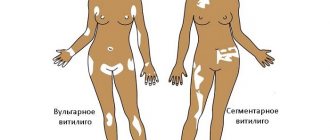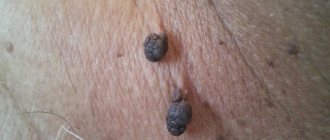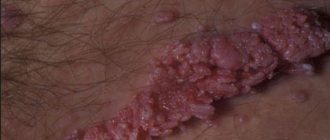18.01.2019
Introduction from D.S.: the article may seem a bit dry and boring if your work is not related to dermato-oncology. If this is the case, you can only read my explanations, they will be highlighted in gray. I have also highlighted the most important passages in the original text bold italics . Reading these fragments will be enough to form an opinion about the problem of spots on the genitals.
Alexandra M. Haugh, BA, Emily A. Merkel, BA, Bin Zhang, MS, Jeffrey A. Bubley, BA, Anna Elisa Verzi, MD, Christina Y. Lee, BA, and Pedram Gerami, MD
A clinical, histologic, and follow-up study of genital melanosis in men and women
Description of the problem: Clinically, genital melanosis is difficult to distinguish from melanoma. There is insufficient data on the risk of developing melanoma due to genital melanosis.
Objectives of the study: To analyze and characterize lesions that are clinically defined as genital melanosis, and to assess the risks of developing genital melanoma and melanoma at other body sites using a retrospective cohort study.
Methods: observation of 41 patients with genital melanosis, as well as analysis of the results of histological examination of the formations.
Results: Genital melanosis may be difficult to distinguish clinically from genital melanoma. However, the first condition develops at an earlier age than the second. Most lesions identified as genital melanosis stabilize or regress. 5 of 41 patients had a history of melanoma. Only one of them had genital melanoma. Most of the formations were characterized by melanocytes with suprabasal migration.
Limitations: The studies were conducted on a small number of patients for a limited time.
Conclusion: patients with genital melanosis, especially with atypia according to histological examination, require regular monitoring. This is necessary to detect the development of melanoma in time.
Genital melanosis is rare. This condition is observed in 0.01% of patients who consult a dermatologist [1, 2]. There is insufficient scientific data on this issue. Manifestations of genital melanosis are atypical. They are characterized by large areas of mucosal pigmentation that are clinically indistinguishable from melanoma. Almost nothing is known about the role of genital melanosis in the development of genital melanoma and melanoma of other skin and mucous membranes.
During the study, researchers observed 41 patients with genital melanosis. They also studied the results of histological studies. Finally, the researchers analyzed the history and incidence of melanoma in patients with genital melanosis. The data obtained should help clinicians choose the right diagnostic and treatment tactics when treating patients with genital melanosis.
Methods
The study involved 41 patients with genital melanosis. The criterion for participation was the presence of a mass larger than 1 cm or multiple associated lesions whose total size exceeded 1 cm.
The patients were divided into two groups according to the size of the formation. The first included participants with formations larger than 1.5 cm, the second included participants with formations less than 1.5 cm.
Biopsies were performed in 35 of the 41 patients. During the histological examination, pathologists assessed, among other things, the following data:
- The number of melanocytes per square millimeter of the epidermis.
- Presence of nuclear atypia.
- Location of melanocytes in the epidermis.
Five patients were biopsied multiple times. Samples with the highest number of melanocytes per square millimeter of epidermis were used for overall statistical analysis.
results
Detailed clinical examination results were available for 38 of the 41 study participants. In 17 cases, the genital lesions were irregular in shape and color. In 22 cases, the lesions had at least two colors, including several shades of brown and black, zones of white or gray regression, and mixed zones of hyper- and hypopigmentation.
The size of 12 lesions exceeded 1.5 cm. 22 patients had multiple lesions, and 19 patients had only one.
The researchers found no significant correlations between clinical manifestations and histological results.
The researchers also checked for a history of human papillomavirus (HPV) infections and inflammatory dermatoses. HPV and inflammatory dermatoses are considered risk factors for the development of genital melanosis. During the analysis, no connection was found between HPV infection and inflammatory dermatoses with clinical or histological manifestations of genital melanosis.
The history of melanoma in close relatives and the person himself was analyzed in 32 and 34 patients, respectively. 7 out of 32 had melanoma in relatives, and 5 out of 34 had melanoma in their personal medical history. Only one patient was diagnosed with genital melanosis and genital melanoma simultaneously. Those. on the genitals of one person in different places (!) both genital melanosis and melanoma were present (approx. D.S.)
No correlation was found between family history of melanoma and clinical manifestations of genital melanosis.
In patients with melanoma, a tendency towards an increase in the number of suprabasally located melanocytes was revealed. The average number of melanocytes per square millimeter was 53.6. In patients without melanoma, this figure was 35.5.
Of the three patients with nuclear atypia in melanocytes, two had a history of melanoma.
Follow-up history is known for 30 of the 41 patients. None of the 30 participants developed genital melanoma. In one patient, genital melanosis developed 10 years after identification and successful removal of genital melanoma.
Detailed descriptions of clinical examination findings are available for 23 patients. Nine of the 23 study participants had unchanged genital lesions over 33 months. Ten of the 23 patients had no evidence of residual lesions 56 months after diagnosis of genital melanosis. Only 2 out of 23 people had relapses after excision of the formations. No correlation was found between the recurrence rate and any histological or clinical features.
The main reasons for the appearance
Experts identify the following most common reasons:
- Hyperpigmentation associated with skin aging.
- Injuries, mechanical damage to the integument (shaving, wearing tight, chafing underwear can also cause spots to appear in the groin area). Post-traumatic pigmentation occurs due to excess melanin production during tissue healing.
- Diseases of the liver, kidneys, gall bladder, gastrointestinal tract. Typically, the structure of such stains is dense with a velvety surface.
- Oncology of internal organs (often malignant neoplasms in the stomach).
- Addison's disease is a rare pathology in which the adrenal glands cannot cope with the production of hormones (in particular, cortisol), which leads to darkening of the groin area, armpits and nipples.
- Intoxication of the body. Poisoning with harmful chemical compounds also affects skin tone. A gradual accumulation of toxic substances is observed in men working in chemical production.
- Hormonal imbalances are more common in adolescents during puberty.
- Fungus (tinea versicolor, trichophytosis, erythrasma, rubrophytosis, epidermophytosis in the groin).
Most often, the reason lies in fungal infections and hyperpigmentation, which is inherent in all men aged 45-70 years.
The discussion of the results
During the study, doctors studied data from clinical observation and histological analysis of 41 patients with genital melanosis. In 22 patients, the formations had several colors; in 11 patients they were more than 1.5 cm.
Researchers considered the average age of onset of this condition to be one of the clinical signs of benign genital melanosis. Among the study participants, it was 41 years. Genital melanoma develops on average in the sixth decade of life.
The researchers concluded that it is necessary to avoid unnecessary surgical intervention for genital melanosis. Clinicians consider it necessary to excise and send for histological examination all formations that seem suspicious to them. In the case of genital melanosis, this approach is not necessary. Most of the lesions examined during the study with clinical atypia, such as multiple colors and larger than 1.5 cm in size, were found to be benign.
Excisional biopsy in the genital area not only causes discomfort for the patient. The operation can harm sexual health and disrupt urinary function. The cosmetic result of the operation may be unfavorable.
Researchers have found that in most cases of genital melanosis, it is sufficient to actively monitor patients. Only one of the 41 study participants had both genital melanosis and genital melanoma. In this patient, genital melanosis was discovered almost 11 years after the diagnosis of vulvar melanoma. The formation was excised, and according to the results of histological examination it was recognized as benign.
During 30.5 months of follow-up, none of the study participants developed genital melanoma due to genital melanosis. In 19 patients who came for examination, the formations stabilized, decreased or disappeared. One patient was diagnosed with recurrence of genital melanosis after excision of the lesion.
Based on these data, the researchers concluded that the risk of genital melanosis transforming into melanoma is so small that it is difficult to measure.
The incidence of genital melanosis in the population is unknown. According to studies [1, 2], this condition occurs in 0.011% of patients who come to see a dermatologist. The incidence of genital melanoma is 0.19 cases per 1 million men and 1.8 cases per 1 million women. [4]
The study found that 15% of the experiment participants had a history of melanoma. In only one out of five cases the tumor was found in the genital area. The average age of patients with melanoma was 39 years.
Scientists have confirmed an increased incidence of genital melanosis in patients with a history of melanoma. Such patients have a suprabasal distribution of melanocytes, as well as an increased number of melanocytes in the epidermis.
Genital melanosis with clinical signs of atypia is recognized as an indication for active monitoring of patients, including examination of the whole body with a dermatoscope. However, according to the study, genital melanosis cannot be considered a precursor to genital melanoma. Therefore, in most cases, in patients with genital melanosis, radical surgery with excision of formations is not indicated.
When are brown spots in the groin area symptoms of a disease?
It happens that along with the appearance of pigmentation in the groin area, a person is also accompanied by various pains, a feeling of malaise and swelling, and it happens that they are discovered completely by accident, and it is not possible to determine how long they have been there. And if in the latter case we are more likely talking about a cosmetic defect that does not pose a threat to health, then in the former these are obvious symptoms of other, more serious diseases that require urgent diagnosis and treatment.
The main types of diseases whose symptoms may include age spots in the groin area:
- Erythrasma;
- Addison's disease;
- Tinea versicolor;
- Cancerous tumor of internal organs;
- Inguinal athlete's foot.
In Addison's disease, there is a disruption in the production of hormones, especially cortisol due to suppression of the adrenal glands, which leads to general disorder in the body and is accompanied by darkening of the nipples, armpits and the appearance of age spots in the groin area. Despite the fact that this disease is indeed very rare, according to world statistics, one in a hundred thousand people suffers from it, mostly women, but men are also susceptible to it.
In case of a cancerous tumor of internal organs - more often with the growth of a malignant neoplasm in the stomach, dark brown spots in the groin in men act as a signal fire. They have a velvety surface and are dense to the touch. In this case, you must definitely contact a gastroenterologist and undergo diagnostics to refute or confirm the presence of the disease. In women, such problems are more often accompanied by characteristic pain and ailments, and age spots appear less frequently.
Modern medicine classifies erythrasma as an infectious pseudomycosis transmitted by contact. With this disease, round, smooth brown spots appear in the groin, armpits, near the anus, on the thighs and other folds of the skin. If left untreated, the lesions begin to change color and increase in size until the extent of the spread becomes quite large. Most often it affects people who do not observe personal hygiene rules, as well as those suffering from obesity. For diagnosis, bacterial culture is carried out to identify the pathogen.
Tinea versicolor is caused by yeast-like fungi - Malassezia furfur and Pityrpsporum orbiculare, which multiply in the stratum corneum of the skin. Typically, these fungi are already present in some quantity on the skin of a potential patient and, under certain favorable circumstances, begin to multiply rapidly. Although the contact method of spreading the disease has not been confirmed, outbreaks of morbidity within the same family are often observed, which can be explained by a genetic predisposition to the disease, but more often its causes are a sharp decrease in immunity and chronic diseases of various types.
Athlete's foot in the groin also refers to diseases caused by the proliferation of fungi on the surface of the skin, or rather in its large folds, which most often include the inguinal-femoral area. At first, you can observe the appearance of small light brown spots about 1 cm in size, later they turn into rings with a clear red border and, increasing in diameter, spread throughout the body. As a rule, diagnosing epidermophytosis by an experienced dermatologist is not difficult and it is enough for him to examine skin flakes removed from the affected area under a microscope.
If you consult a doctor in a timely manner, as in most cases of fungal skin infections, the disease can be cured in a few weeks, subject to strict adherence to preventive measures and the use of prescribed medications.
SUMMARY FROM D.S.:
This study shows that age spots on the genitals are, in the vast majority of cases, NOT DANGEROUS. However, researchers note a possible increased risk of developing skin melanoma (not just the genitals, but also other areas) in people with genital melanosis. This means that if you have similar pigment spots, they must be examined annually with a dermatoscope by an oncologist or dermatologist, just like ALL other pigmented skin formations.











